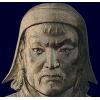 A
valuable finding, the silver coins of the Golden Horde or White Horde, was discovered
in 1939 at the Spassky Tower of the Kremlin. These coins dated back to 14th century.
Yet, such hoards are sporadic only in central and northern lands of Russia but they
are common in eastern and southern regions, as Crimea and Kazakhstan.
Volga
region – the center of the White Horde A
valuable finding, the silver coins of the Golden Horde or White Horde, was discovered
in 1939 at the Spassky Tower of the Kremlin. These coins dated back to 14th century.
Yet, such hoards are sporadic only in central and northern lands of Russia but they
are common in eastern and southern regions, as Crimea and Kazakhstan.
Volga
region – the center of the White Horde
Lower
and Middle Volga region became the principal political center in the White
Horde (Ulus Djuchi), the state ruled by Genghis Khan offsprings in XIII century.
These are places rich in countless golden accessories and hoards of coins since
the Golden Horde time. So, a plenty of hidings have been found in the lands of Chuvashia,
close to Cheboksary town. The most inscrutible coins among the others are those
from Kerman, the town that was supposed to exist in the territory of the modern
settlement Almenyevo in Chuvashia.
There was a hoard discovered in 1938 of more than two
hundred sixteen coins dated back to 13th century. The inscription “K..rman”
on the coins evoked the idea they came from the old town Kerman. There was no other
precise evidence of this land existance and thus, the place of origin of these
coins is still a mystery to investigators.
In the territory of modern Tatarstan and Samara region
in the Russian Federation the hoard of coins from the White Horde is rather habitual
to discover. So, in 1891 a pot full of silver Ulus Dzhuchi coins was found in
the suburbs of Gubino village and the similar dig totalling in four hundred and
sixteen coins was discovered near Vinnovka settlement in 1908. Nevertheless, Samarskaya
Luka, the winding bend, formed by the Zhigulev Mountains and the Volga River
gut, is the most “fruitful” place to find coins. So, this is the place where the
site of ancient town was opened there in 2002 referring to the White Horde
period. Along with the household items various coins were discovered in the settlement,
including dirhems that would circulate in ancient Arab countries around 8th century.
South of Russia and the Crimea land
The Crimea and the other south regions in Russia are
rich in coin treasures. So, in 2009 the Museum of Money in Feodosiya got three
hundred thirty five coins from one of the coin collectors dating back to the
very White Horde period. There was one and the only in the Ukraine silver
dirhem of Tula-Bugi Khan dated back to 1290 among the coins. That silver coin
has the imprint of the panther on it. In view of researchers, the Mongol-Tatar tribes,
subject to the Turkic culture, had their own 12-year cycle where a particular
animal “patronized” the particular year. And that unique coin was devoted to the
coming year of Panther, that was the year 1291.
The
Museum in Voronezh acquired over five hundred silver coins from the time of Tokhtamysh:
the local art patron bought those coins and granted them to the museum. The name of the granter and cost of the collection were
hidden but the hoard was assumed to be found in 1920.
Kazakhstan region
The
scientists assume that the ancient settlement Saraychik situated in fifty km from
Atyrau city, Kazakhstan, is the site where lots of coin treasures were
discovered of the White Horde period. Sometime
back that settlement was like the administrative center of the eastern
provinces of the White Horde. The investigation
of that ancient settlement was initiated in the 18th century that has been lasting
till now. A huge pile of silver and copper coins of the 18th -19th
centuries was dug in there with the names of rulers imprinted on coins. Such findings
are of the essentially value for scientists from historic point of view.
Nowadays, the Saraychik settlement has been destroying
too fast and its prominent part is washed away in the Ural River already (in
Kazakh language this River is called Zhayik). The witnesses tell that the White
Horde coins can be found even on the bank of the river or got from local
traders for a song. It’s unknown whether the secrets will be revealed on the
coins origin or will be buried too to discover again and again with the time.
|